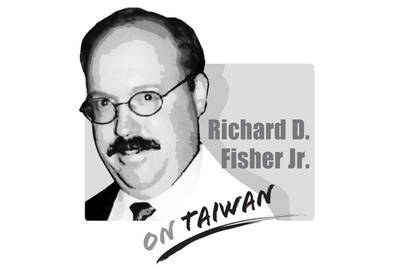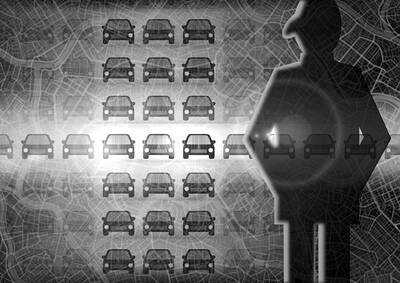How long has it been since you saw news about the Belt and Road Initiative? China has not talked about it for half a year, and its Taiwanese cheer squad has also fallen silent.
In August last year, Malaysian Prime Minister Mahathir Mohamad announced the termination of his nation’s big East Coast Rail Link contract with China after he was given the cold shoulder during a visit to Beijing.
Two months later on Oct. 4 when the US-China trade dispute was picking up speed, US Vice President Mike Pence delivered a speech on China at the Hudson Institute in Washington. That was when the world finally saw through the expansionist ambition behind the initiative.
China intended to export its overcapacity in the railway, highway and airport sectors while creating a debt trap to hold other countries hostage, all while supporting corrupt, puppet regimes, of which Venezuela is blood-drenched proof.
It remains uncertain to what extent Chinese President Xi Jinping (習近平) has fulfilled his “China dream” since announcing his strategic goal in 2014.
However, his spendthrift policy has caused a domestic backlash, as the widening poverty gap is intensifying the sense of deprivation and planting the seeds of social unrest.
Xi has had no choice but to spend huge amounts of money to stabilize the situation, further intensifying China’s debt crisis.
Knowing that he could not continue, Xi changed his approach. On Feb. 18, the Chinese State Council announced the Guangdong-Hong Kong-Macau Greater Bay Area plan, which is to bring together Hong Kong, Macau and nine cities in the Pearl River Delta to an economic zone covering 56,000km2 and 66 million people.
The plan adds to the mirage of China’s economic prosperity, which is created by printing money and flipping property. The combined market value of properties in Beijing, Shanghai, Shenzhen and Guangzhou exceeds the value of all property in the US.
Last year, China’s broad money supply, M2, increased by 174 trillion yuan (US$26 trillion at the current exchange rate), more than twice its GDP, and the total market value of its housing market is five times its GDP.
The bubble economy is growing and no one knows how to fix it.
Economics 101 says that printing two dollars to produce something worth one dollar leads to inflation.
However, China uses forceful controls to distort economic laws and directs huge capital flows toward the real-estate market, using it as a reservoir and turning 1.4 billion Chinese into mortgage slaves while the government reaps great financial benefit. As the public’s purchasing power weakens, they have no choice but to become docile, obedient citizens.
Now that the Belt and Road Initiative is broken, China is turning to Hong Kong. Once trapped, the “one country, two systems” framework will be put to sleep and Hong Kongers’ assets will dry up.
Worse still, Hong Kong will lose its century-old reputation for financial freedom as it is sacrificed in the competition between the great powers.
China’s economic volume is 63 percent that of the US, but it issues two times more yuan than the US issues dollars, while the real value of the yuan is anyone’s guess. This is how “red capital” survives.
Late last year, Taiwanese yuan deposits hit nearly 300 billion yuan, but the value of yuan-denominated financial instruments is unclear, something those who fantasize about the currency should consider.
As for Taiwanese businesspeople who have funds trapped in China, all that can be done is to wish them good luck.
Chen Chih-ko is a non-professional investor and a resident of New Taipei City.
Translated by Chang Ho-ming
Concerns that the US might abandon Taiwan are often overstated. While US President Donald Trump’s handling of Ukraine raised unease in Taiwan, it is crucial to recognize that Taiwan is not Ukraine. Under Trump, the US views Ukraine largely as a European problem, whereas the Indo-Pacific region remains its primary geopolitical focus. Taipei holds immense strategic value for Washington and is unlikely to be treated as a bargaining chip in US-China relations. Trump’s vision of “making America great again” would be directly undermined by any move to abandon Taiwan. Despite the rhetoric of “America First,” the Trump administration understands the necessity of

US President Donald Trump’s challenge to domestic American economic-political priorities, and abroad to the global balance of power, are not a threat to the security of Taiwan. Trump’s success can go far to contain the real threat — the Chinese Communist Party’s (CCP) surge to hegemony — while offering expanded defensive opportunities for Taiwan. In a stunning affirmation of the CCP policy of “forceful reunification,” an obscene euphemism for the invasion of Taiwan and the destruction of its democracy, on March 13, 2024, the People’s Liberation Army’s (PLA) used Chinese social media platforms to show the first-time linkage of three new
The military is conducting its annual Han Kuang exercises in phases. The minister of national defense recently said that this year’s scenarios would simulate defending the nation against possible actions the Chinese People’s Liberation Army (PLA) might take in an invasion of Taiwan, making the threat of a speculated Chinese invasion in 2027 a heated agenda item again. That year, also referred to as the “Davidson window,” is named after then-US Indo-Pacific Command Admiral Philip Davidson, who in 2021 warned that Chinese President Xi Jinping (習近平) had instructed the PLA to be ready to invade Taiwan by 2027. Xi in 2017

If you had a vision of the future where China did not dominate the global car industry, you can kiss those dreams goodbye. That is because US President Donald Trump’s promised 25 percent tariff on auto imports takes an ax to the only bits of the emerging electric vehicle (EV) supply chain that are not already dominated by Beijing. The biggest losers when the levies take effect this week would be Japan and South Korea. They account for one-third of the cars imported into the US, and as much as two-thirds of those imported from outside North America. (Mexico and Canada, while